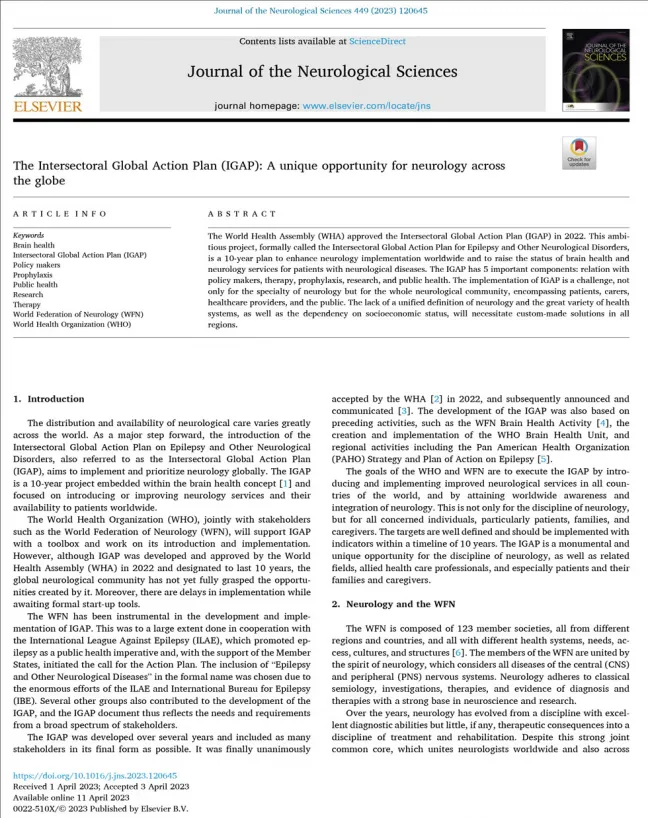
 By Wolfgang Grisold, Morris Freedman, Riadh Gouider, Alla Guekht, Steven Lewis, Marco Medina, Chandrashekhar Meshram, Guy Rouleau, Richard Stark, on behalf of the Trustees of the World Federation of Neurology
By Wolfgang Grisold, Morris Freedman, Riadh Gouider, Alla Guekht, Steven Lewis, Marco Medina, Chandrashekhar Meshram, Guy Rouleau, Richard Stark, on behalf of the Trustees of the World Federation of Neurology
Abstract
The World Health Assembly (WHA) approved the Intersectoral Global Action Plan (IGAP) in 2022. This ambitious project, formally called the Intersectoral Global Action Plan for Epilepsy and Other Neurological Disorders, is a 10-year plan to enhance neurology implementation worldwide and to raise the status of brain health and neurology services for patients with neurological diseases.
The IGAP has 5 important components: relation with policy makers, therapy, prophylaxis, research, and public health. The implementation of IGAP is a challenge, not only for the specialty of neurology but for the whole neurological community, encompassing patients, carers, healthcare providers, and the public. The lack of a unified definition of neurology and the great variety of health systems, as well as the dependency on socioeconomic status, will necessitate custom-made solutions in all regions.
Introduction
The distribution and availability of neurological care varies greatly across the world. As a major step forward, the introduction of the Intersectoral Global Action Plan on Epilepsy and Other Neurological Disorders, also referred to as the Intersectoral Global Action Plan (IGAP), aims to implement and prioritize neurology globally. The IGAP is a 10-year project embedded within the brain health concept [1] and focused on introducing or improving neurology services and their availability to patients worldwide.
The World Health Organization (WHO), jointly with stakeholders such as the World Federation of Neurology (WFN), will support IGAP with a toolbox and work on its introduction and implementation. However, although IGAP was developed and approved by the World Health Assembly (WHA) in 2022 and designated to last 10 years, the global neurological community has not yet fully grasped the opportunities created by it. Moreover, there are delays in implementation while awaiting formal start-up tools.
The WFN has been instrumental in the development and implementation of IGAP. This was to a large extent done in cooperation with the International League Against Epilepsy (ILAE), which promoted epilepsy as a public health imperative and, with the support of the Member States, initiated the call for the Action Plan. The inclusion of “Epilepsy and Other Neurological Diseases” in the formal name was chosen due to the enormous efforts of the ILAE and International Bureau for Epilepsy (IBE). Several other groups also contributed to the development of the IGAP, and the IGAP document thus reflects the needs and requirements from a broad spectrum of stakeholders.
The IGAP was developed over several years and included as many stakeholders in its final form as possible. It was finally unanimously accepted by the WHA [2] in 2022, and subsequently announced and communicated [3]. The development of the IGAP was also based on preceding activities, such as the WFN Brain Health Activity [4], the creation and implementation of the WHO Brain Health Unit, and regional activities including the Pan American Health Organization (PAHO) Strategy and Plan of Action on Epilepsy [5].
The goals of the WHO and WFN are to execute the IGAP by introducing and implementing improved neurological services in all countries of the world, and by attaining worldwide awareness and integration of neurology. This is not only for the discipline of neurology, but for all concerned individuals, particularly patients, families, and caregivers. The targets are well defined and should be implemented with indicators within a timeline of 10 years. The IGAP is a monumental and unique opportunity for the discipline of neurology, as well as related fields, allied health care professionals, and especially patients and their families and caregivers.
Read full article in the Journal of the Neurological Sciences. 2023 Apr 11:120645 ⧉ .
References
- K. Kolappa, K. Seeher, T. Dua. Brain health as a global priority J. Neurol. Sci., 439 (2022), Article 120326
- World Health Assembly Available from https://www.who.int/about/governance/world-health-assembly (2023)
- World Federation of Neurology Intersectoral Global Action Plan on Epilepsy and Other Neurological Disorders Available from https://wfneurology.org/activities/calendar/igap-on-epilepsy-and-other-nd (2022)
- World Federation of Neurology Brain Health Initiative Available from https://wfneurology.org/brain-health-initiative (2023)
- Pan American Health Organization Strategy and plan of action on epilepsy: Final report 30th Pan American Sanitary Conference: 74th Session of the Regional Committee of WHO for the Americas; September 26-30, 2022; Washington, D.C., USA (2022)







